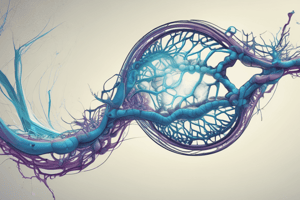Podcast
Questions and Answers
What is the study of interactions between organisms and their environment?
What is the study of interactions between organisms and their environment?
- Ecology (correct)
- Microbiology
- Botany
- Genetics
What is the characteristic of life that refers to living things maintaining a stable internal environment?
What is the characteristic of life that refers to living things maintaining a stable internal environment?
- Evolution
- Homeostasis (correct)
- Metabolism
- Organization
What is the organelle responsible for generating energy for the cell?
What is the organelle responsible for generating energy for the cell?
- Lysosomes
- Mitochondria (correct)
- Nucleus
- Ribosomes
What type of molecule stores genetic information in the form of DNA and RNA?
What type of molecule stores genetic information in the form of DNA and RNA?
What is the process by which cells generate energy from glucose?
What is the process by which cells generate energy from glucose?
What study of biology focuses on the structure and function of cells?
What study of biology focuses on the structure and function of cells?
What is the study of the physical principles underlying biological processes?
What is the study of the physical principles underlying biological processes?
What is the process of cell division that results in four non-identical daughter cells?
What is the process of cell division that results in four non-identical daughter cells?
Flashcards are hidden until you start studying
Study Notes
Branches of Biology
- Botany: study of plants
- Zoology: study of animals
- Microbiology: study of microorganisms
- Ecology: study of interactions between organisms and their environment
- Biochemistry: study of chemical processes in living organisms
- Molecular Biology: study of biological molecules and their interactions
- Cellular Biology: study of cell structure and function
- Genetics: study of heredity and variation
- Evolutionary Biology: study of evolution and diversity of life
- Marine Biology: study of organisms in the ocean
- Biophysics: study of physical principles underlying biological processes
Characteristics of Life
- Organization: living things are composed of cells
- Metabolism: living things carry out chemical reactions to maintain homeostasis
- Homeostasis: living things maintain a stable internal environment
- Growth and Development: living things grow and develop over time
- Reproduction: living things produce offspring
- Response to Stimuli: living things respond to changes in their environment
- Evolution: living things change over time through genetic variation and natural selection
Cell Structure
- Cell Membrane: semi-permeable membrane that surrounds the cell
- Cytoplasm: jelly-like substance inside the cell membrane
- Nucleus: control center of the cell where DNA is stored
- Mitochondria: organelles responsible for generating energy for the cell
- Ribosomes: organelles responsible for protein synthesis
- Lysosomes: organelles responsible for breaking down and recycling cellular waste
Biological Molecules
- Carbohydrates: provide energy for the cell
- Proteins: perform a variety of functions in the cell
- Lipids: provide energy and structure for the cell
- Nucleic Acids: store genetic information in the form of DNA and RNA
- ATP: energy currency of the cell
Biological Processes
- Photosynthesis: process by which plants convert sunlight into energy
- Respiration: process by which cells generate energy from glucose
- Mitosis: process of cell division that results in two identical daughter cells
- Meiosis: process of cell division that results in four non-identical daughter cells
- Gene Expression: process by which genetic information is converted into a functional product
Branches of Biology
- Botany is the study of plants, including their structure, growth, evolution, and interactions with the environment
- Zoology is the study of animals, including their structure, behavior, evolution, and interactions with the environment
- Microbiology is the study of microorganisms, including bacteria, viruses, and other tiny life forms
- Ecology is the study of interactions between organisms and their environment, including the impact of human activities on the environment
- Biochemistry is the study of chemical processes that occur within living organisms, including metabolism and energy production
- Molecular Biology is the study of biological molecules, including DNA, RNA, and proteins, and their interactions
- Cellular Biology is the study of cell structure and function, including cell division, growth, and communication
- Genetics is the study of heredity and variation, including the transmission of traits from one generation to the next
- Evolutionary Biology is the study of evolution and diversity of life, including the processes that have shaped the history of life on Earth
- Marine Biology is the study of organisms that live in the ocean, including their evolution, behavior, and interactions with their environment
- Biophysics is the study of physical principles underlying biological processes, including the structure and function of molecules and cells
Characteristics of Life
- Living things are composed of one or more cells, which are the basic structural and functional units of life
- Metabolism is the process by which living things carry out chemical reactions to maintain homeostasis and support growth and development
- Homeostasis is the ability of living things to maintain a stable internal environment despite changes in the external environment
- Growth and Development are the processes by which living things increase in size and complexity over time
- Reproduction is the process by which living things produce offspring, allowing populations to grow and evolve over time
- Response to Stimuli is the ability of living things to respond to changes in their environment, including light, temperature, and touch
- Evolution is the process by which living things change over time through genetic variation and natural selection
Cell Structure
- The Cell Membrane is a semi-permeable membrane that surrounds the cell and regulates the movement of materials in and out
- Cytoplasm is a jelly-like substance inside the cell membrane where many metabolic processes take place
- The Nucleus is the control center of the cell where DNA is stored and transcribed into RNA
- Mitochondria are organelles responsible for generating energy for the cell through cellular respiration
- Ribosomes are organelles responsible for protein synthesis, where mRNA is translated into a sequence of amino acids
- Lysosomes are organelles responsible for breaking down and recycling cellular waste and foreign substances
Biological Molecules
- Carbohydrates are biological molecules that provide energy for the cell, including sugars, starches, and cellulose
- Proteins are biological molecules that perform a variety of functions in the cell, including structural, enzymatic, and signaling roles
- Lipids are biological molecules that provide energy and structure for the cell, including fats, oils, and waxes
- Nucleic Acids are biological molecules that store genetic information in the form of DNA and RNA
- ATP is the energy currency of the cell, providing energy for metabolic processes and other cellular activities
Biological Processes
- Photosynthesis is the process by which plants, algae, and some bacteria convert sunlight into energy, producing glucose and oxygen
- Respiration is the process by which cells generate energy from glucose, releasing carbon dioxide and water as byproducts
- Mitosis is the process of cell division that results in two identical daughter cells, essential for growth, development, and tissue repair
- Meiosis is the process of cell division that results in four non-identical daughter cells, essential for sexual reproduction
- Gene Expression is the process by which genetic information is converted into a functional product, including transcription and translation
Studying That Suits You
Use AI to generate personalized quizzes and flashcards to suit your learning preferences.




